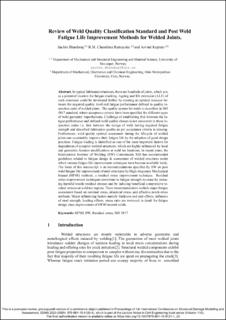| dc.contributor.author | Bhardwaj, Sachin | |
| dc.contributor.author | Keprate, Arvind | |
| dc.contributor.author | Chandima Ratnayake, Mudiyanselage | |
| dc.date.accessioned | 2021-01-28T10:38:36Z | |
| dc.date.accessioned | 2021-03-05T09:59:26Z | |
| dc.date.available | 2021-01-28T10:38:36Z | |
| dc.date.available | 2021-03-05T09:59:26Z | |
| dc.date.issued | 2020-12-13 | |
| dc.identifier.citation | Bhardwaj S, Ratnayake Mudiyanselage R.M.C, Keprate A. Review of Weld Quality Classification Standard and Post Weld Fatigue Life Improvement Methods for Welded Joints. Lecture Notes in Civil Engineering. 2020;110:257-270 | en |
| dc.identifier.isbn | 978-981-15-9120-4 | |
| dc.identifier.isbn | 978-981-15-9121-1 | |
| dc.identifier.issn | 2366-2557 | |
| dc.identifier.issn | 2366-2565 | |
| dc.identifier.uri | https://hdl.handle.net/10642/9879 | |
| dc.description.abstract | In typical fabricated structures, there are hundreds of joints, which acts as a potential location for fatigue cracking. Ageing and life extension (ALE) of such structures could be developed further by creating an optimal measure between the required quality level and fatigue performance defined in quality inspection code of welded joints. The quality system for welds is described in ISO 5817 standard, where acceptance criteria have been specified for different types of weld geometry imperfections. Challenge of establishing link between the fatigue performance and defined weld quality classes is not consistent in these inspection codes i.e. link between the design of weld having required fatigue strength and described fabrication quality as per acceptance criteria is missing. Furthermore, weld quality optimal assessment during the lifecycle of welded joints can sustainably improve their fatigue life by the adoption of good design practices. Fatigue loading is identified as one of the most important factors for degradation of complex welded structures, which are highly influenced by local and geometric features modifications at weld toe locations. In recent years, the International Institute of Welding (IIW) Commission XIII has recommended guidelines related to fatigue design and assessment of welded structures under which various fatigue life improvement techniques have become available lately. The focus of this manuscript is on recommendations specified by IIW on post weld fatigue life improvement of steel structures by High-frequency Mechanical Impact (HFMI) methods, a residual stress improvement technique. Residual stress improvement techniques contribute to fatigue strength increase by reducing harmful tensile residual stresses and by inducing beneficial compressive residual stresses at weld toe regions. These recommendations include major fatigue assessment based on nominal stress, structural stress, and effective notch stress methods. Major influencing factors namely thickness and size effects, influence of steel strength, loading effects, stress ratio are reviewed in detail for fatigue design class improvement of HFMI treated welds. | en |
| dc.description.sponsorship | This work has been carried out as part of a PhD research project, performed at the University of Stavanger, Norway. The research is fully funded by the Norwegian Ministry of Education. | en |
| dc.language.iso | en | en |
| dc.publisher | Springer | en |
| dc.relation.ispartof | Proceedings of 1st International Conference on Structural Damage Modelling and Assessment, SDMA 2020 | |
| dc.relation.ispartofseries | Lecture Notes in Civil Engineering;Volume 110 | |
| dc.rights | This is a post-peer-review, pre-copyedit version of a conference object published in Proceedings of 1st International Conference on Structural Damage Modelling and Assessment, SDMA 2020 (ISBN: 978-981-15-9120-4), which is part of the Lecture Notes in Civil Engineering book series (Volume 110).
The final authenticated version is available online at: https://doi.org/10.1007/978-981-15-9121-1_20 | en |
| dc.subject | High frequency mechanical impacts | en |
| dc.subject | International Institute of Welding | en |
| dc.subject | ISO 5817 | en |
| dc.subject | Residual stress | en |
| dc.subject | Welding | |
| dc.title | Review of Weld Quality Classification Standard and Post Weld Fatigue Life Improvement Methods for Welded Joints | en |
| dc.type | Conference object | |
| dc.date.updated | 2021-01-28T10:38:36Z | |
| dc.description.version | acceptedVersion | en |
| dc.identifier.doi | https://doi.org/10.1007/978-981-15-9121-1_20 | |
| dc.identifier.cristin | 1860739 | |
| dc.source.journal | Lecture Notes in Civil Engineering | |
| dc.relation.projectID | Norges forskningsråd: IN-12168 | |
